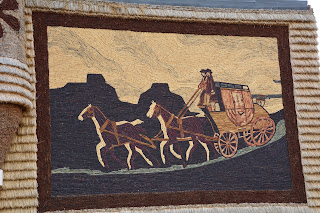Blog post for May 19 -
That would be the Corn Palace in Mitchell, South Dakota, about 1/3 of the way from Sioux Falls to the Badlands. Today, on the drive back from our Mercedes get-away, we stopped to take in the sights. Western South Dakota and the Black Hills are considered the gateway to the west. The eastern part of the state is solid Midwestern farm country, where corn is ing — and a king, of course, has got to have a castle.
In 1892, the town of Mitchell built its first Corn Palace as a home for the Corn Belt Exposition, a showcase of agricultural straight. The current building is the palace’s third incarnation, dating from 1921. Hugh murals around its exterior are mosaics composed entirely of corn, grains, and local grasses. Each year a new decorating theme is chosen and the outside murals are stripped and redecorated with new corn, roughly 275 thousand ears that are sawed in half lengthwise and nailed to the building following patterns created by local artists - a sot of “corn-by-number” picture, as Doris, the volunteer docent told us.
The annual process begins each spring when local farmers plant 12 different colors of corn in carefully separated plots to ensure plants don’t cross-pollinate and dilute the purity of the colors. In late August the mural images are transferred from sketches to roofing paper, which is nailed into place on the walls of the palace. Then the crew go to work cutting and nailing to the paper the ears of corn to create the variegated images for which theCorn Palace is famous.
Here are some of the images -
First a greeting by an ear of corn.
To create the decorative frames around the images, artisans combine bundles of rye grass and sour dock, a hearty prairie plant, and staple the bundles to the frames.
This sculpture,by Marilyn Wounded Head, is displayed in a small park across the street from the Corn Palace. It depicts a bird atop a person and is meant to show a co-existence of man, animals, and societal or physical environment. The sculptures was influenced by Oscar Howe and by the stories her mother told her of a time when man, animals, and the environment communicated with one another.
Oscar Howe, the Yanktonai Sioux Indian artist, designed the Corn Palace Murals from 1948 to 1971. His work drew inspiration from Sioux tradition, arts and beliefs. His murals, which are displayed inside the Corn Palace, are not changed yearly and will remain just as he designed them.
The Corn Palace has, for years, boasted onion domes reminiscent of the cathedrals of St. Petersburg. But this year the Corn Palace is undergoing a facelift.
The onion domes are being replaced with leafy, organic sculptures.
This is how the design sketches on roofing paper tell the crew which corn variety to use to create the design.
The completed picture.
Inside the Corn Palace they are just beginning to set up the gift show that runs through the summer months.
We next stopped at the Rest Stop and scenic overlook in Chamberlain, just above the Missouri River where the Lewis and Clark Corps of Discovery stopped and camped for a few days both at the beginning of their journey and on the return trip.
Commemorative plate.
The Missouri River from the viewpoint.
“Asparagus” yucca on the bluff above the river.
Juniper berries. We have seen many juniper shrubs/trees loaded with these berries.
Stylized tipi at the Visitor Center. Each Visitor Center is identified with tipis like this one.
Inside the VisitorCenter there were quite a number of exhibits depicting the Lewis and Clark Expedition. This tipi is unique because you can still see the tails on the buffalo hides that cover the tipi poles.























Loved the Corn Palace! Judy S.
ReplyDelete